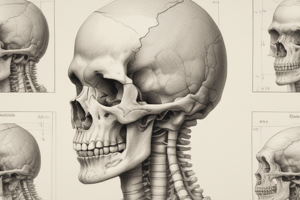Podcast
Questions and Answers
Benign tumors are less common than malignant tumors.
Benign tumors are less common than malignant tumors.
True (A)
Bone tumors are usually symptomatic and easily detectable.
Bone tumors are usually symptomatic and easily detectable.
False (B)
Pathological fractures are associated with bone tumors.
Pathological fractures are associated with bone tumors.
True (A)
Radiological imaging methods play a minor role in diagnosing bone tumors.
Radiological imaging methods play a minor role in diagnosing bone tumors.
Malignant bone tumors are more common in older adults.
Malignant bone tumors are more common in older adults.
Osteoblastoma tumors are smaller than 2 cm in size.
Osteoblastoma tumors are smaller than 2 cm in size.
Aspirin can effectively relieve pain caused by osteoblastoma.
Aspirin can effectively relieve pain caused by osteoblastoma.
Osteoblastoma tumors cause significant bone reaction.
Osteoblastoma tumors cause significant bone reaction.
Malignant transformation of osteoblastoma is common.
Malignant transformation of osteoblastoma is common.
Osteoblastoma is primarily treated by chemotherapy.
Osteoblastoma is primarily treated by chemotherapy.
Osteoid osteoma is typically larger than 2 cm in size.
Osteoid osteoma is typically larger than 2 cm in size.
Osteoid osteoma is commonly found in elderly patients.
Osteoid osteoma is commonly found in elderly patients.
Severe nocturnal pain is a common symptom of osteoid osteoma.
Severe nocturnal pain is a common symptom of osteoid osteoma.
Radiofrequency ablation is a common treatment for osteoblastoma.
Radiofrequency ablation is a common treatment for osteoblastoma.
Osteoid osteoma is typically located in the medulla of bones.
Osteoid osteoma is typically located in the medulla of bones.
Osteosarcoma is a benign bone tumor.
Osteosarcoma is a benign bone tumor.
Osteosarcoma is the most common primary malignant tumor of bone.
Osteosarcoma is the most common primary malignant tumor of bone.
Secondary osteosarcoma can be caused by a history of Paget's disease.
Secondary osteosarcoma can be caused by a history of Paget's disease.
The male/female ratio for osteosarcoma is 1:16.
The male/female ratio for osteosarcoma is 1:16.
The most common sites of involvement in adolescents with osteosarcoma are the metaphysis of the distal femur and proximal fibula.
The most common sites of involvement in adolescents with osteosarcoma are the metaphysis of the distal femur and proximal fibula.
Osteochondroma is a malignant tumor.
Osteochondroma is a malignant tumor.
Osteochondroma is also known as Endosteosis.
Osteochondroma is also known as Endosteosis.
In 85% of cases, osteochondromas are multiple lesions.
In 85% of cases, osteochondromas are multiple lesions.
Hereditary syndromes can be associated with osteochondromas.
Hereditary syndromes can be associated with osteochondromas.
Mutations in the EXT1 or EXT2 gene can lead to osteochondromas.
Mutations in the EXT1 or EXT2 gene can lead to osteochondromas.
Flashcards are hidden until you start studying




